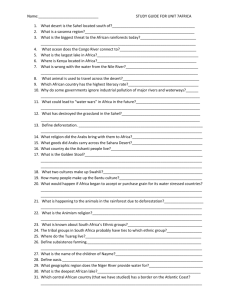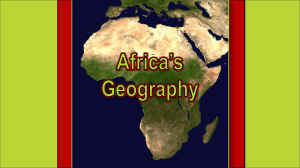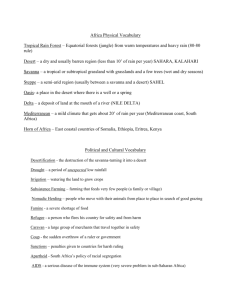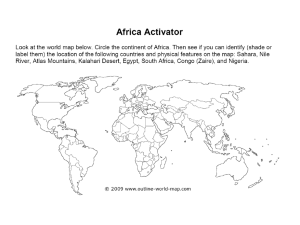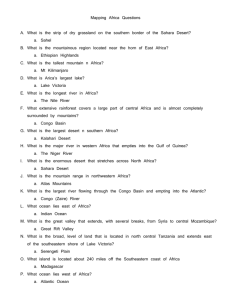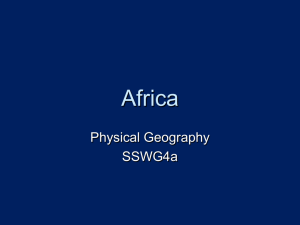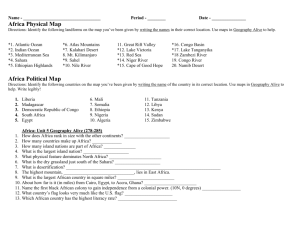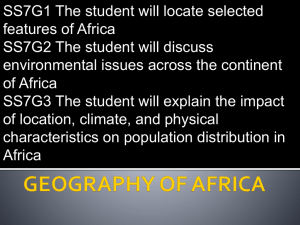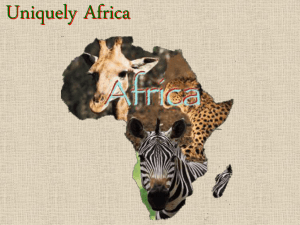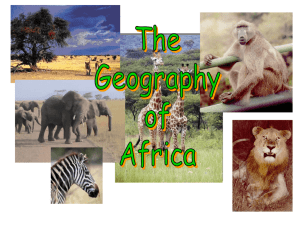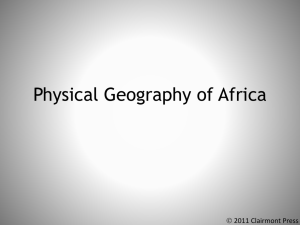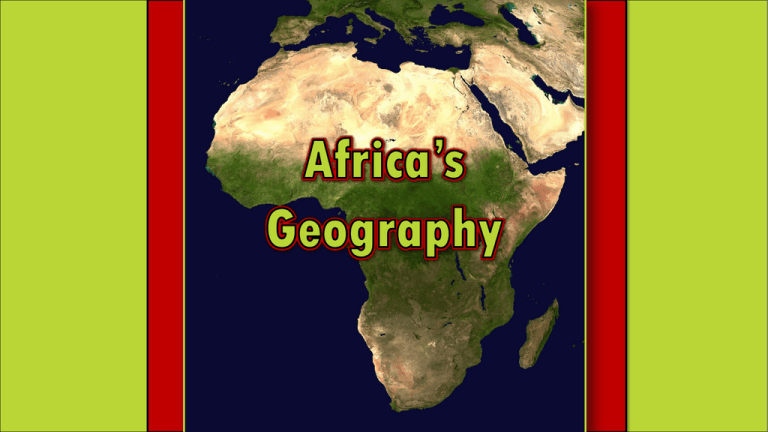
Standards
SS7G1 The student will locate selected features of Africa.
a. Locate on a world and regional political-physical map: the Sahara, Sahel,
Sahel, savanna, tropical rain forest, Congo River, Niger River, Nile River,
Lake Tanganyika, Lake Victoria, Atlas Mountains, and Kalahari Desert.
b. Locate on a world and regional political-physical map the countries of
Democratic Republic of the Congo (Zaire), Egypt, Kenya, Nigeria, South
Africa, Sudan, and South Sudan.
Teachers
Print off the following 3 pages for each
student. They should use an atlas to label the
political and physical features of Africa.
Teachers
Print off the following page for each student.
They should complete the chart while
discussing the presentation.
• Africa is the world’s second largest continent (11,700,000 miles).
• It is home to 52 countries, 1,000 different languages, and 800 million people.
• 10% of the world’s population lives in Africa.
• The one thing that all African nations have in common is their reliance on the
land’s physical characteristics, which affect where people live, work, & trade.
• Africa can be divided into many different regions:
• The Sahara, the Sahel, the savannahs, the tropical rain forests, the Ethiopian
Highlands, and Southern Africa.
• The Sahara is the world’s largest desert (3,500,000 miles).
• It runs across the width of northern Africa.
• It covers 1/3rd of the continent.
• It divides the continent into two distinct regions – North Africa and subSaharan Africa.
• The Sahara is covered with sand dunes, rocky hills, and stretches of gravel that
continue for miles and miles.
• Very few people live in the desert because it is considered one of the harshest
places to live in the world.
• The people who do live here are called nomads.
• They move from place to place, usually traveling by camel, looking for food &
water.
• The Sahel is a strip of dry grassland that is located south of the Sahara.
• The word “Sahel” means “border” or “margin”.
• It is the region between the desert to the north and the grasslands and
rainforest to the south.
• It is a dry, semi-arid region that is slowly turning into desert.
• It gets more rainfall than the desert, but still receives very little, ranging from
6-20 inches.
• People have tried to live here but generations of overgrazing and desertification
have caused soil erosion.
• Vegetation is sparse here—grasses are shrubs are unevenly distributed.
• The Sahel is relatively flat with few mountains and hills.
• The African savannas are hot, dry grasslands that are located near the Equator
and cover almost half of Africa.
• They actually cover the regions just north and south of the rainforests that
lie along the equator.
• The African savanna is the largest in the world.
• There is a large variety of wildlife here, including lions, zebras, & elephants.
• Farming is good here, but only if there is good rainfall.
• Grasses and grains like wheat, oats, and sorghum grown in the region.
• The area receives enough rain to support drought resistant undergrowth, but not
enough to support forest-type vegetation.
• Grasses are tall and thick, while trees are short and scattered.
• Africa’s tropical rain forest is located along the central coast of Africa, near the
Equator.
• It lies in the Congo River Basin.
• The rain forest covers 1/5th of the land surface of Africa and touches 37 countries.
• The rain forest has a hot, humid climate.
• The annual rainfall is over 17 feet.
• There is a large variety of animals found in this region.
• Trees are so thick and tall that sunlight never reaches the forest floor!
• The trees grow hundreds of feet tall.
• It’s the second largest rain forest in the world; the Amazon rain forest in Brazil is the
largest.
• Unfortunately, this rain forest has shrunk due to deforestation.
• The Congo River is located in western central Africa.
• It begins in central Africa, near Lake Tanganyika,
and flows west through the tropical rain forest.
• The Congo River is the second largest river in Africa.
• It’s over 3,000 miles long.
• The Niger River is located in western Africa.
• It flows through Guinea, Mali, Niger, Benin, & Nigeria.
• The Niger River is the third largest river in Africa.
• It runs over 2,600 miles.
• The mouth of the Niger River flows through a large delta,
often referred to as the “Oil Delta” because of the petroleum
industry that’s centered here.
• The Nile River is located in eastern Africa.
• It starts in East Burundi and flows northward and
empties into the Mediterranean Sea.
• The Nile is the world’s longest river at 4,150 miles.
• It provides water for Sudan and Egypt.
• It’s an important waterway for transporting people and
goods.
• The Nile also provides a source of irrigation for agriculture.
• Lake Tanganyika is located in central Africa.
• It’s divided between Burundi, Congo, Tanzania,
and Zambia.
• Lake Tanganyika is the deepest lake in Africa and one
of the deepest in the world.
• It’s also one of the largest freshwater lakes in the
world.
• Lake Victoria is the largest lake in Africa and the second
largest freshwater lake in the world (Lake Superior is the
largest).
• It is located in central Africa and extends into three
countries: Tanzania, Uganda, and Kenya.
• White Nile begins here.
• Lake Victoria is vital in supporting the millions of people
that live nearby.
• It provides a living for many fishermen and attracts
millions of tourists each year.
• The Atlas Mountains are a mountain range in north Africa.
• The mountains extend from Morocco to Tunisia, between the
Mediterranean Sea and the Sahara desert.
• They separate the coastal regions from the Sahara Desert.
• The Kalahari Desert is located in southwestern Africa.
• It covers parts of Botswana, Namibia, and South Africa.
• The region is surrounded by semi-arid areas that are slowly becoming
more dry.
• It is not a “true” desert because it receives 3-10 inches of rain per
year.
• Because of the precipitation and underground water supplies, grass,
shrubs, and wild animals manage to live in the Kalahari desert.
Physical Features Class Quilt – Teacher Directions
•
Divide the class into groups of 11 .
•
Give each student a quilt patch handout.
•
Each student will create a “quilt patch” for 1 of the 11 physical features in Africa.
•
Have the students tape all 11 patches together to create the “quilt”.
•
*To make the quilt “even”, have the students work together to make a patch
about Africa in general (size, features, people, climate, location, etc.)
Physical Features Hot Seat Review –
Teacher Directions
•
Write the names of the 11 physical features on sticky notes and randomly place
them under students’ chairs.
•
Have all students check their seats and if they have a feature, they have to either
describe it or say where it’s located.
•
Another variation—project a blank map of Africa on the board & have
students place the sticky where the feature is located.
Teachers
Thank you for downloading this file. I hope you enjoy using it with your students, and
I can’t wait to read your feedback in my TPT store!
• For more social studies materials, please visit my store:
http://www.teacherspayteachers.com/Store/Brain-Wrinkles
• I teach 6th grade Language Arts and Social Studies in Georgia, so my products are
aligned with Common Core (LA) and Georgia Performance Standards (SS).
© Copyright 2013. Brain Wrinkles. All rights reserved. Permission is granted to copy pages specifically designed for student or
teacher use by the original purchaser or licensee. The reproduction of any other part of this product is strictly prohibited.
Copying any part of this product and placing it on the Internet in any form (even a personal/classroom website) is strictly
forbidden. Doing so makes it possible for an Internet search to make the document available on the Internet, free of charge, and is
a violation of the Digital Millennium Copyright Act (DMCA).
Credits:
All photos were found via Creative Commons and labeled for reuse.
• Fonts:
• Backgrounds & Graphics:

